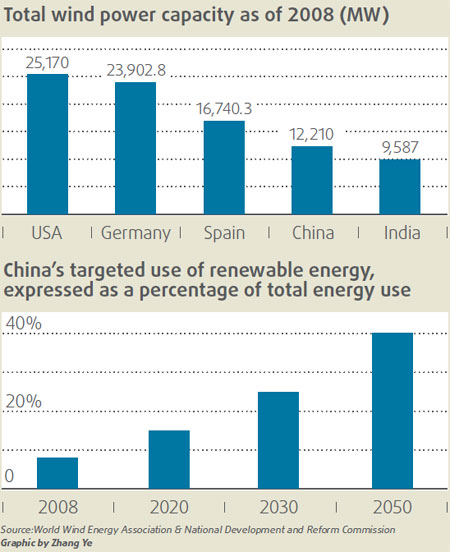

|
A wind farm dominates the landscape in Gansu province. Zhang Heping |
|
More wind farms are being constructed all the time as the demand for renewable energy increases. Liu Jian |
China has set a target for renewable energy consumption of 40 percent of the market by the year 2050.
The news comes as it emerges that China will have 100 GW of wind power capacity by 2020, more than three times the 30 GW the government set as a target 18 months ago.
It's also been revealed that China will become the biggest growth market for wind power generating capacity this year, ahead of the United States, which has been worse-hit by the economic downturn, according to the Global Wind Energy Council (GWEC).
China is the fourth largest producer of wind power after the United States, Germany and Spain.
The annual growth rate in wind power in China will be about 20 percent, Fang Junshi, head of the coal department of the National Energy Administration, told a Coaltrans conference in Beijing.
China, the world's second largest energy user, has around 12 GW of wind power capacity and has said it wants to raise that to around 20 GW by next year. That means wind is set to be a bigger source of power than nuclear, despite a construction boom in nuclear power plants, and far bigger than solar, which is expected to hit 1.8 GW by 2020, according to a 2007 plan.
More than 27 GW of wind power generating plants worth about $53 billion were built around the world last year. Demand for power in China has been spurred by economic stimulus measures.
"China is powering ahead with no visible signs of slowing down," said Steve Sawyer of the Brussels-based GWEC. "If anything it is accelerating. They intend to become the largest market in the world, very clearly, and they probably will unless things take off in the US again in the relatively near term."
China's local wind turbine manufacturing industry has "grown dramatically" as power production has expanded, Sawyer said. Local manufacturers, dominated by Sinovel Wind Co, Xinjiang Goldwind Science & Technology Co and Dongfang Electric Corp, captured more than half the domestic market for the first time in 2007, rising to between 75 percent and 80 percent last year.
"Although all the big international brands are there and their markets are growing in absolute terms, their market share is diminishing pretty rapidly," Sawyer said.
The growth in Chinese wind turbine manufacturing means Chinese-made equipment is poised to emerge in the international wind market "in earnest", Sawyer said.
Until now, Chinese suppliers have only won smaller contracts in the US, Cuba, Peru, Africa and the Middle East, he said.
Danish company Vestas, the world's largest wind turbine maker, plans to invest $9 million in its factory in Inner Mongolia to produce about 800 sets of V60-turbines every year. These turbines are specially tailored for Inner Mongolia's low to medium strength winds, being shorter with bigger blades than standard turbines. The factory will employ an additional 1,000 Chinese people, about half of its current local employees.
The company, which entered the Chinese market in 1986, has a market share of about 12 percent. This pales in comparison with local competitors such as Sinovel, Goldwind and DEC, which took about 65 percent of market share in 2008, according to Shi Pengfei, vice-president of the China Wind Energy Association.
The World Wind Energy Report 2008 predicts that Asia, under China's lead, will "become the worldwide locomotive for the wind industry" and "Chinese wind turbine manufacturers will be among the top international suppliers".
Wang Jun, director of the National Energy Administration's renewable energy department, said: "Renewable energy will become the mainstream power supply in 2050 from a supplementary role in 2010." He envisaged a future with heating dependent on solar and geothermal power, cars driven using biofuels and families owning their own photovoltaic power stations, turning the country from the world's biggest emitter of greenhouse gases to one of its smallest.
However, some are worried that too much attention and aid is being paid to the renewable energy industry. They argue China should focus on clean coal technology.
"Renewable energy is our destiny, but it is not the solution to China's urgent problem of large-scale coal burning," said Feng Xiaoting, director of Jiangsu Coal Chemical Engineering Institute.
He said he believes that in the next 30 to 40 years, traditional energy, especially coal, will still be the powerhouse for China's growth. He said clean coal technology research and development should be prioritized.

(China Daily 05/04/2009 page7)













